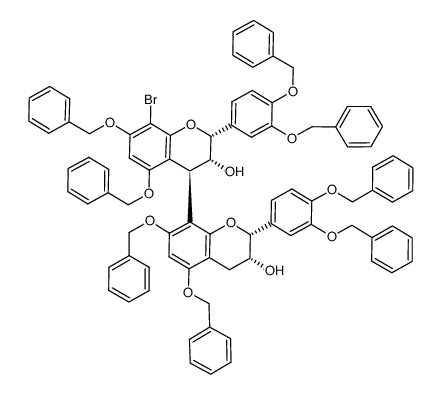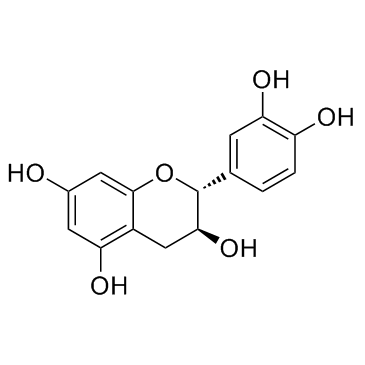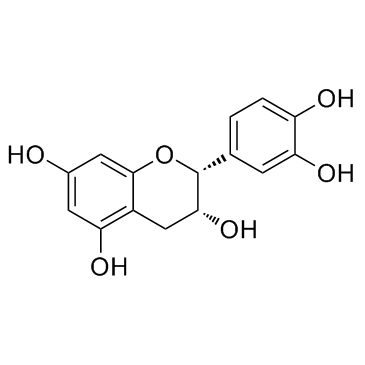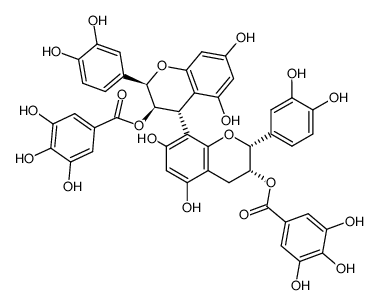29106-49-8
| Name | procyanidin B2 |
|---|---|
| Synonyms |
Proanthocyanidin B3
Proanthocyanidin B2 (2R,2'R,3R,3'R,4R)-2,2'-Bis(3,4-dihydroxyphenyl)-3,3',4,4'-tetrahydro-2H,2'H-4,8'-bichromene-3,3',5,5',7,7'-hexol (2R,3S)-2-(3,4-dihydroxyphenyl)-8-[(2R,3S,4S)-2-(3,4-dihydroxyphenyl)-3,5,7-trihydroxy-3,4-dihydro-2H-chromen-4-yl]-3,4-dihydro-2H-chromene-3,5,7-triol 4,8"-Bi-[(+)-epicatechin] PROCYANIDINDIMERB2 EPICATECHIN(4BETA->8)EPICATECHIN Procyanidol B2 (-)epicatechin-(-)-epicatechin Procyanidin B2 EPICATECHIN(4B-8)EPICATECHIN ProcyanidinB2 PROCYANIDIN B1(P) Procyanidin B-3 Proanthocyanidin UNII-L88HKE854X 4,8'-BI-[(+)-EPICATECHIN] 2,3-trans-proanthocyanidin [4,8'-Bi-2H-1-benzopyran]-3,3',5,5',7,7'-hexol, 2,2'-bis(3,4-dihydroxyphenyl)-3,3',4,4'-tetrahydro-, (2R,2'R,3R,3'R,4R)- |
| Description | Procyanidin B2 is a natural flavonoid, with anti-cancer, antioxidant activities. |
|---|---|
| Related Catalog | |
| In Vitro | Procyanidin B2 shows antiproliferative activity to MCF-7 cells, with an IC50 of 19.21 μM. However, Procyanidin B2 exhibits no effect on DNA-ladder formation[1]. Procyanidin B2 (0.1, 1, 2 μM) inhibits the activation of pyrin domain containing 3 (NLRP3) inflammasome in human umbilical vein ECs (HUVECs), and the inhibition is via suppression of AP-1 activity, and such effect can be abolished by overexpression of c-Jun. Procyanidin B2 (2 μM for 12 h) also reduces ROS in HUVECs[2]. |
| In Vivo | Procyanidin B2 (40, 20, and 10 mg/kg, p.o.) protects against cerebral ischemia-induced infarct volume and brain edema in rats. Procyanidin B2 (40 mg/kg, p.o) also improves functional outcomes, regulates blood-brain barrier (BBB) permeability after cerebral ischemia. Moreover, Procyanidin B2 attenuates cerebral ischemia-induced tight junction degradation, mitochondrial depolarization and intracellular oxidative stress. Procyanidin B2 (40 mg/kg, p.o) increases Nrf2 activation and HO-1, GSTα, and NQO1 protein expression in normal brains in vivo[3]. |
| Cell Assay | MCF-7 cells are grown in 5 mL of RPMI 1640 medium supplemented with 20% fetal bovine serum, penicillin (100 U/mL) and streptomycin (100 μg/mL). Cells are maintained at 37°C in a humidified atmosphere of 5% CO2 in air and subcultured every 3 days. Exponentially growing cells are plated at a seeding density of 2×104 cells/mL, in 96-well plates or in dishes. After overnight incubation to allow for attachment, the cells are exposed for 24 or 48 h to various concentrations of Procyanidin B2 (0.5; 1.0; 5.0; 10.0; 25.0 and 50.0 μM) diluted in distilled water. Two millimolar cyclophosphamide (CP) is used as the positive control and solutions are sterilised by filtration[1]. |
| Animal Admin | To observe the effect of Procyanidin B2 on infarct size or brain edema, 40 rats are randomLy separated into five groups, and each group is administered with vehicle (equivalent dose of 0.9% saline administered via gavage) or 40, 20, or 10 mg/kg of Procyanidin B2, respectively. To elucidate the effect of Procyanidin B2 on blood-brain barrier (BBB) permeability, the rats (n = 6 per group for Evans blue extravasation and n = 4 per group for IgG leakage) are randomLy separated into two groups: vehicle and Procyanidin B2 (40 mg/kg). Procyanidin B2 (40 mg/kg) is administered intragastrically once a day starting at 3 h after middle cerebral artery occlusion (MCAO). For other observations, including immunohistological staining and western blot analysis, rats are randomLy separated into three groups: sham-operated, vehicle, and Procyanidin B2 (n = 4 per group). Procyanidin B2 (40 mg/kg) is administered intragastrically once a day starting at 3 h after MCAO. To elucidate the improvement in neurological function after ischemic stroke in rats, the rats (n = 8 per group) undergo neurobehavioral assays to evaluate the functional outcome after administration of Procyanidin B2 (40 mg/kg) once a day starting at 24 h after MCAO. The neurological deficits are assessed at 1, 3, 7, 11, and 14 days after MCAO[3]. |
| References |
| Density | 1.7±0.1 g/cm3 |
|---|---|
| Boiling Point | 955.3±65.0 °C at 760 mmHg |
| Melting Point | 197-198ºC |
| Molecular Formula | C30H26O12 |
| Molecular Weight | 578.520 |
| Flash Point | 531.6±34.3 °C |
| Exact Mass | 578.142456 |
| PSA | 220.76000 |
| LogP | 0.30 |
| Vapour Pressure | 0.0±0.3 mmHg at 25°C |
| Index of Refraction | 1.803 |
| Storage condition | 2-8°C |
| Personal Protective Equipment | Eyeshields;Gloves;type N95 (US);type P1 (EN143) respirator filter |
|---|---|
| Safety Phrases | 22-24/25 |
| RIDADR | NONH for all modes of transport |
| Precursor 9 | |
|---|---|
| DownStream 3 | |


![5,7,3',4'-tetra-O-benzyl-(-)-epicatechin-(4β,8)-[5,7,3',4'-tetra-O-benzyl-(-)-epicatechin] structure](https://image.chemsrc.com/caspic/027/223387-28-8.png)


![(2R-trans)-2-[3,4-bis(phenylmethoxy)phenyl]-3,4-dihydro-5,7-bis(phenylmethoxy)-2H-1-benzopyran-3-ol structure](https://image.chemsrc.com/caspic/113/20728-73-8.png)
![(2R)-2-[3,4-bis(phenylmethoxy)phenyl]-5,7-bis(phenylmethoxy)-4H-chromen-3-one structure](https://image.chemsrc.com/caspic/087/87292-54-4.png)

![(2R,3R)-2-[3,4-bis(phenylmethoxy)phenyl]-4-(2-hydroxyethoxy)-5,7-bis(phenylmethoxy)-3,4-dihydro-2H-chromen-3-ol structure](https://image.chemsrc.com/caspic/235/256236-25-6.png)


